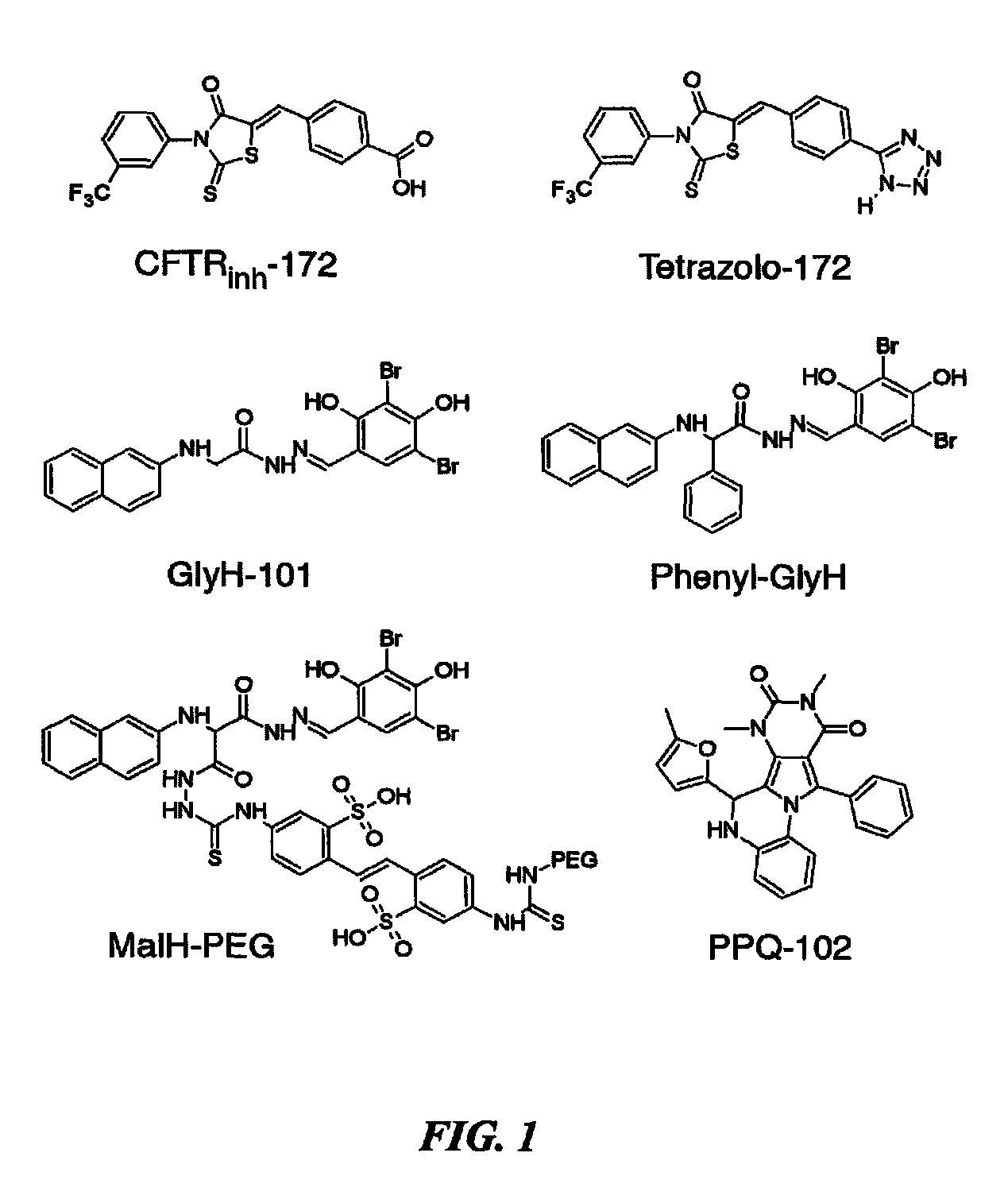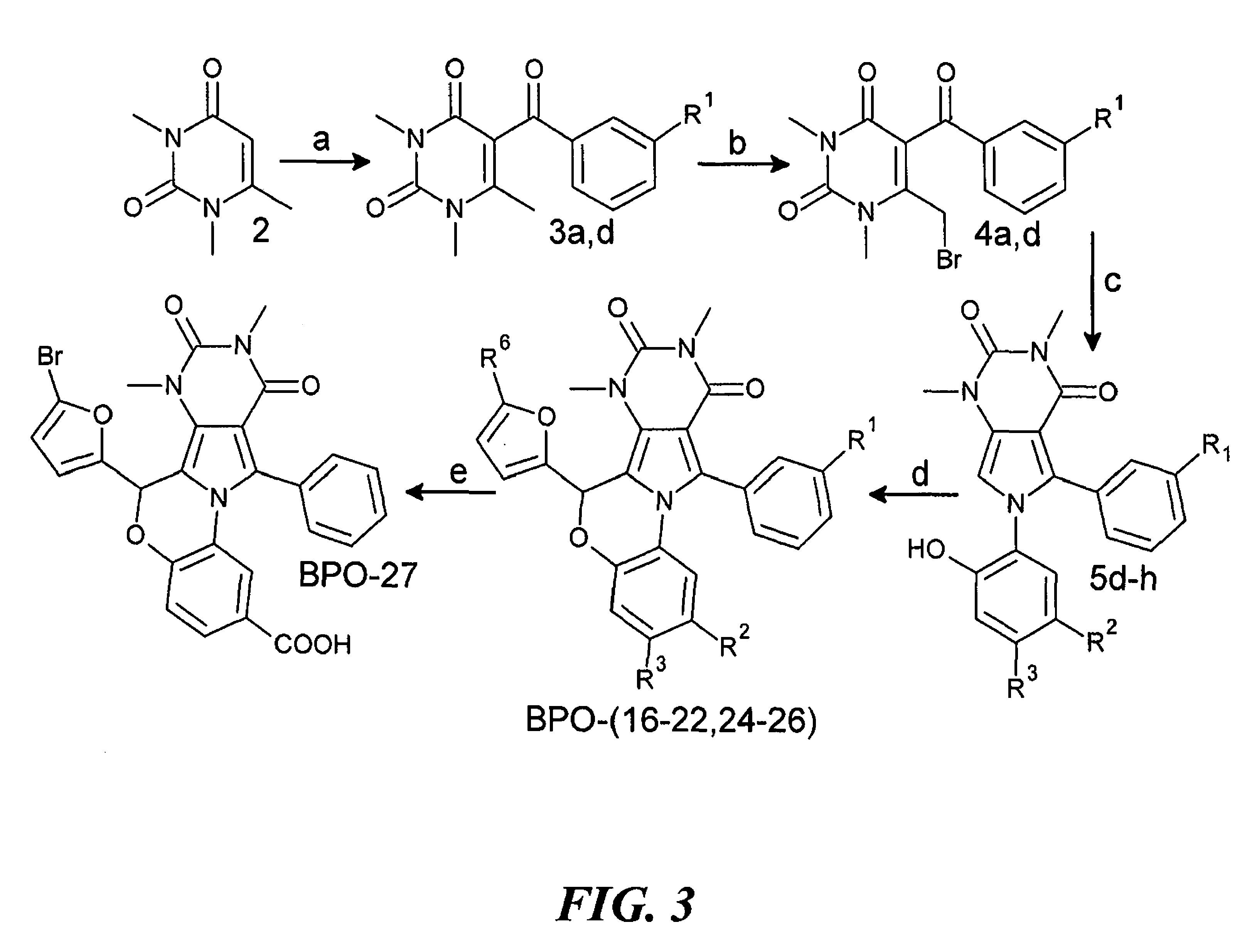Pyrimido-pyrrolo-oxazine-dione compound inhibitors of the cystic fibrosis transmembrane conductance regulator protein and uses therefor
a technology of transmembrane conductance regulator and compound inhibitor, which is applied in the field of pyrimidopyrrolooxazinedione compound inhibitors of the cystic fibrosis transmembrane conductance regulator protein and uses therefor, can solve the problems of ineffective antibiotic treatment of many pathogens, weak potency, and lack of cftr specificity, and achieve excellent aqueous solubility, inhibit kidney cyst enlargement, and polar polar
- Summary
- Abstract
- Description
- Claims
- Application Information
AI Technical Summary
Benefits of technology
Problems solved by technology
Method used
Image
Examples
example 1
Overview of Chemistry Procedures
[0466]Synthesis Overview: NMR spectra (1H at 600 MHz; 13C at 150 MHz) were obtained in methylene chloride (CD2Cl2), chloroform (CDCl3), acetonitrile (CD3CN) or dimethyl sulfoxide (DMSO-d6) using a 600-MHz Varian Spectrometer. Chemical shifts are expressed in parts per million relative to the solvent. NMR spectra for PPQ and BPO compounds were acquired at −20° C. due to excessive broadening of the 11-phenyl protons at ambient temperature. NMR spectra for the intermediates were obtained at ambient temperature. Mass spectrometry was done using a Waters LC / MS instrument with MS: electrospray (+) ionization, mass ranging from 100 to 900 Da, 20-V cone voltage; LC: Xterra MS C18 column (2.1 mm×50 mm×3.5 μm), 0.2 mL / min water / acetonitrile (containing 0.1% TFA). Purity was judged by the peak area percentage of the UV absorbance signal. Compound purities by RP-HPLC were >98%. Flash chromatography was done using EM silica gel (230-400 mesh), and thin-layer chrom...
example 2
Synthesis of BPO-27
[0472]
[0473]Modification of PPQ-102 by bromine substitution at the 5-position of the furan ring, replacement of the secondary amine with an ether bridge, and carboxylation, gave BPO-27. Synthesis of BPO-27 is described below.
[0474]1,3,6-Trimethyl-1H,3H-pyrimidine-2,4-dione (2) See, e.g., Azas et al., Farmaco. 58:1263-70 (2003). In a 250 mL round bottom flask, 6-methyluracil (1; 15.0 g, 119 mmol) and NaOH (9.55 g, 239 mmol) were dissolved in water (150 mL) at low heat. The solution was brought to 25° C. in an ice bath and maintained at 25° C. while dimethyl sulfate (23 mL, 30.59 g, 243 mmol) was added dropwise over 20 min with vigorous stirring. After 22 h, the reaction mixture contained a white precipitate and had pH 9. NaOH (5.0 g, 125 mmol) was added to make the solution homogenous, and an ice bath was used to maintain a temperature of 25° C. while dimethyl sulfate (12 ml, 15.96 g, 127 mmol) was added dropwise over 10 min. The reaction was stirred for 72 h, then...
example 2a
Separation of Enantiomers of BPO-27
[0483]Separation of Enantiomers—Separation of approximately 1.0 gram of racemic BPO-27 was carried out by Averica Discovery Services Inc. Preparative scale chiral SFC was carried out on a RegisCell 3.0×25.0 cm column using an isocratic method: 75% CO2, and 25% ethanol containing 1% isopropylamine, 80 mL / min, 100 bar, 25° C. Analysis of the separated enantiomers was carried out on a RegisCell 4.6×100 mm column, using an isocratic method: 75% CO2, 25% ethanol with 0.1% isopropylamine, 4 mL / min, 100 bar, 25° C. Two distinct peaks were seen following chromatography (FIG. 4A). Fraction 1 contained 413 mg with 99.5% e.e. (FIG. 4B), and fraction 2 contained 396 mg with 98.6% e.e. (FIG. 4C).
[0484]Crystal Preparation—Fraction 1, BPO-27 isopropylamine carboxylate (30 mg, 49 mmol) was placed in a 75 ml separatory funnel filled with very dilute HCl (aq) (20 ml) and EtOAc (20 ml). The mixture was shaken vigorously until no undissolved solids remained. The EtOAc...
PUM
| Property | Measurement | Unit |
|---|---|---|
| mole fraction | aaaaa | aaaaa |
| mole fraction | aaaaa | aaaaa |
| mole fraction | aaaaa | aaaaa |
Abstract
Description
Claims
Application Information
 Login to View More
Login to View More - R&D
- Intellectual Property
- Life Sciences
- Materials
- Tech Scout
- Unparalleled Data Quality
- Higher Quality Content
- 60% Fewer Hallucinations
Browse by: Latest US Patents, China's latest patents, Technical Efficacy Thesaurus, Application Domain, Technology Topic, Popular Technical Reports.
© 2025 PatSnap. All rights reserved.Legal|Privacy policy|Modern Slavery Act Transparency Statement|Sitemap|About US| Contact US: help@patsnap.com



